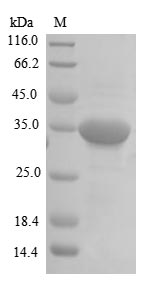Recombinant Human Repulsive guidance molecule A (RGMA) is produced in E. coli and includes the full-length mature protein spanning amino acids 169 to 424. The protein features an N-terminal 10xHis-tag and a C-terminal Myc-tag, which help with purification and detection processes. SDS-PAGE analysis confirms a purity level exceeding 85%, making it appropriate for various research applications.
RGMA belongs to the repulsive guidance molecule family. It appears to play a critical role in axon guidance and neural development. The protein is involved in signaling pathways that may influence neural patterning and regeneration, which has made it a subject of considerable interest in neurobiology research. Understanding RGMA's interactions and functions could provide insights into nervous system development and potential therapeutic approaches for neural repair.
Potential Applications
Note: The applications listed below are based on what we know about this protein's biological functions, published research, and experience from experts in the field. However, we haven't fully tested all of these applications ourselves yet. We'd recommend running some preliminary tests first to make sure they work for your specific research goals.
Human RGMA is a neuronal guidance protein that requires precise folding and disulfide bond formation for its functional activity in axon guidance and neural development. The E. coli expression system cannot perform the necessary eukaryotic post-translational modifications (particularly proper disulfide bonding) that are critical for RGMA's native conformation. The dual N-terminal His-tag and C-terminal Myc-tag may sterically interfere with proper folding and functional domain presentation. While the protein may be soluble, it is highly unlikely to achieve the correct folding needed for functional activity. The probability of correct folding with biological activity is low.
1. Antibody Development and Validation Studies
This recombinant RGMA serves as an excellent immunogen for generating antibodies against linear epitopes of human RGMA. The mature protein sequence ensures comprehensive epitope coverage. The dual tags facilitate purification and provide additional epitopes for screening. However, antibodies may not efficiently recognize conformational epitopes on the native, properly folded RGMA found in biological systems.
2. ELISA-Based Binding Assays
This protein is well-suited as a standard for quantitative ELISA to detect immunoreactive RGMA levels. The assay depends on antibody binding to linear epitopes, so the protein's folding state is less critical. The dual tags enable flexible immobilization and detection strategies for reliable standard curve generation.
3. Biochemical Characterization and Stability Studies
This is the essential first step to assess the protein's physical properties. Techniques like size-exclusion chromatography can determine oligomeric state, while circular dichroism can analyze secondary structure content and thermal stability. These studies provide critical quality control data but characterize a misfolded protein, not native RGMA.
Final Recommendation & Action Plan
The E. coli expression system is fundamentally unsuitable for producing a functional version of this complex neuronal guidance protein, limiting its applications to non-functional uses. The protein can be reliably used for Application 1 (Antibody Development) and Application 2 (as an ELISA standard). Application 3 (Biochemical Characterization) should be prioritized to understand the protein's physical properties. Neuronal guidance protein interactions require a precise tertiary structure that this human RGMA cannot provide. For functional RGMA studies, the only valid approach is to use the protein expressed in a eukaryotic system (e.g., mammalian cells) that can provide proper disulfide bond formation and folding.




